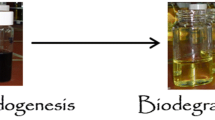Abstract
Previous works (Beccari et al. 1999b; Beccari et al. 2001a; Beccari et al. 2001b)on the anaerobic treatment of olive oil mill effluents (OME) have shown: (a) apre-treatment based on the addition of Ca(OH)2 and bentonite was able toremove lipids (i.e. the most inhibiting substances present in OME) almostquantitatively; (b) the mixture OME – Ca(OH)2 – bentonite, fed to amethanogenic reactor without providing an intermediate phase separation,gave way to high biogas production even at very low dilution ratios; (c) theeffluent from the methanogenic reactor still contained significant concentrationsof residual phenolic compounds (i.e. the most biorecalcitrant substances present inOME). Consequently, this paper was aimed at evaluating the fate of the phenolicfractions with different molecular weights during the sequence of operations(adsorption on bentonite, methanogenic digestion, activated sludge post-treatment).The results show that a very high percentage (above 80%) of the phenolic fractionbelow 500 D is removed by the methanogenic process whereas the phenolic fractionsabove 1,000 D are significantly adsorbed on bentonite; the 8-day activated sludgepost-treatment allows an additional removal of about 40% of total filtered phenoliccompounds. The complete sequence of treatments was able to remove more than the96% of the phenolic fraction below 500 D (i.e. the most toxic fraction towards plantgermination). Preliminary respirometric tests show low level of inhibition exerted bythe effluent from the methanogenic reactor on aerobic activated sludges taken fromfull-scale municipal wastewater plants.
Similar content being viewed by others
References
Aliotta G, Cafiero R, De Feo V, Di Blasio B, Iacovino R & Oliva A (2000) Allelochemicals from Rue (Ruta graveolens L.) and Olive (Olea europaea L.) oil mill waste waters as potential natural pesticides, Current Topics in Phytochemistry 3: 167
Beccari M, Bonemazzi F, Majone M & Riccardi C (1996) Interaction between acidogenesis and methanogenesis in the anaerobic treatment of olive oil mill effluents. Wat. Res. 30: 183-189
Beccari M, Carucci G, Majone M & Torrisi L (1999a) Role of lipids and phenolic compounds in the anaerobic treatment of olive oil mill effluents. Environ. Technol. 20: 105-110
Beccari M, Majone M, Riccardi C, Savarese F & Torrisi L (1999b) Integrated treatment of olive oil mill effluents: effect of chemical and physical pretreatment on anaerobic treatability. Wat. Sci. Tech. 40: 347-355
Beccari M, Petrangeli Papini M, Majone M & Torrisi L (2001a) Enhancement of anaerobic treatability of olive oil mill effluents by addition of Ca(OH)2 and bentonite without intermediate solid/liquid separation, Wat. Sci. Tech. 43: 275-282
Beccari M, Carucci G, Lanz AM, Majone M & Petrangeli Papini M (2001b) Fate of the phenolic fractions in an integrated treatment of olive oil mill effluents (adsorption on bentonite, methanogenesis, activated sludge post-treatment). In: AIDIC (Ed), Proceedings of IcheaP-5, the fifth Italian Conference on Chemical and Process Engineering, Florence, May, 20-23, Vol. 1 (pp. 357-362)
Bertin L, Majone M, Di Gioia D & Fava F (2001) An aerobic fixed-phase biofilm reactor system for the degradation of the low molecular weight aromatic compounds occurring in the effluents of anaerobic digestors treating olive mill wastewaters. Journal of Biotechnology 87: 161-177
Capasso R (1997) The chemistry, biotechnology and ecotoxicology of the polyphenols naturally occurring in vegetable wastes. Current Topics in Phytochemistry 1: 145
Folin O & Ciocalteu V (1927) On tyrosine and tryptofan determinations in protein. J. Biol. Chem. 73: 627-650
Hamdi M (1991) Effects of agitation and pretreatment on the batch anaerobic digestion of olive mill waste water. Bioresource Technology 36: 173-178
Hanaki K, Matsuo T & Nagase M (1981) Mechanism of inhibition caused by long chain fatty acids in anaerobic digestion process. Biotechnol. Bioeng. 23: 1591-1610
IRSA (1985a) Metodi analitici per i fanghi. Vol. 3. Parametri chimico-fisici. Quaderni Istituto di Ricerca sulle Acque, 64, CNR, Roma (in Italian)
IRSA (1985b) Quaderni Istituto di Ricerca sulle Acque, 70, CNR, Roma (in Italian)
ISTAT (2000). Indice di rivalutazione della lira, in: Annuario 2000, Ed. ISTAT, Roma (in Italian)
Koster IW & Cramer A (1980) Inhibition of methanogenesis from acetate in granular sludge by long-chain fatty acids. Appl. Environ. Microbiol. 53: 403-409
Majone M, Beccari M, Petrangeli Papini M & Torrisi L (2000) Processo integrato chimico-fisico e biologico per il trattamento di reflui di frantoi oleari (Acque di vegetazione, AV). European Patent no. 01115896.1-1213
Martin A, Borja R & Banks CJ (1994) Kinetic model for substrate utilization and methane production during the anaerobic digestion of olive mill wastewater and condensation water waste. J. Chem. Tech. Biotechnol. 60: 7-16
Montedoro G, Servili M, Baldioli M & Miniati E (1992) Simple and hydrolyzable phenolic compounds in virgin olive oil. 1. Their extraction, separation, and quantitative and semiquantitative evaluation by HPLC. Journal of Agricultural and Food Chemistry 40(9): 1571-1576
Paredes C, Bernal MP, Roig A & Cegarra J (2001) Effects of olive mill wastewater addition in composting of agroindustrial and urban wastes. Biodegradation 12: 225-234
Author information
Authors and Affiliations
Rights and permissions
About this article
Cite this article
Beccari, M., Carucci, G., Lanz, A.M. et al. Removal of molecular weight fractions of COD and phenolic compounds in an integrated treatment of olive oil mill effluents. Biodegradation 13, 401–410 (2002). https://doi.org/10.1023/A:1022818229452
Issue Date:
DOI: https://doi.org/10.1023/A:1022818229452




